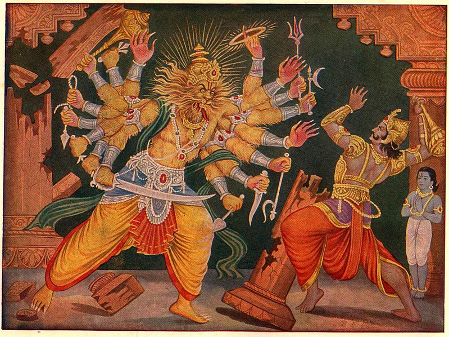NARASINGH (Man-lion incarnation) The Lord manifested Himself by tearing off the column and killed the egoistic demon. (Bhairo M. 3, p. 1154) The Lord came out of the column assuming huge size and killed Hiranyaksha (Hiranyakashipu) with his nails. That Supreme Purusha and God of gods manifested Himself as Narsingh for His devotee. (Basant Kabir, p. 1194) Vishnu assumed the form of man-lion in order to save the •world from the tyranny of the demon king Hiranyakashipu. He had propitiated Brahma and become invulnerable.
No god, man or animal could kill him during day or night. He could not be slain inside or outside the palace. He was thus highly puffed up with ego and wanted his subjects to worship him. His own son Prahlada was a great devotee of Vishnu and did not leave his devotion at any cost. The tyrant tried to kill his son. He wanted to know if the Lord of Prahlada was omnipresent; was he present within the column of the palace ? In great rage, he struck the column violently, whereupon, Vishnu came out of the column, tearing it off, vindicating the honour of His devotee.
He had assumed the form of a man-lion (who is neither a man nor an animal). He was killed in twilight (which was neither day nor night). He was killed at the doorstep (neither inside nor outside of the palace). See : Prahlada , Hiranyakashipu , Das Avataras (man-lion).
References :
1. Kohli,Surindar Singh ed,Dictionary of Mythological References in Guru Granth Sahib 1993
Narasingh, also known as Narasimha, is one of the most celebrated avatars of Lord Vishnu in Hindu mythology. His name translates to “man-lion” (Nara meaning man and Simha meaning lion), reflecting his unique form as half-human and half-lion. Narasingh is revered for his role in protecting his devotee Prahlada and restoring dharma (righteousness) by defeating the tyrannical demon king Hiranyakashipu.
Key Aspects of Narasingh:
The Fourth Avatar of Vishnu:
- Narasingh is the fourth incarnation in Vishnu’s Dashavatara (ten avatars), appearing during the Satya Yuga.
- His form was specifically designed to bypass the boons granted to Hiranyakashipu by Lord Brahma, which made him immune to death by man, beast, weapon, or in specific locations and times.
The Legend of Prahlada:
- Hiranyakashipu, after receiving his boons, declared himself invincible and forbade the worship of Vishnu. However, his son Prahlada remained a devout follower of Vishnu, defying his father’s orders.
- Enraged by Prahlada’s devotion, Hiranyakashipu subjected him to various tortures, but Vishnu protected him each time.
Narasingh’s Appearance:
- Vishnu incarnated as Narasingh to fulfill the conditions of Hiranyakashipu’s boon. He appeared at twilight (neither day nor night), on the threshold of the palace (neither indoors nor outdoors), and killed Hiranyakashipu with his claws (neither weapon nor hand) while holding him on his lap (neither earth nor sky).
Symbolism:
- Narasingh represents the triumph of good over evil and the protection of devotees. His fierce form symbolizes divine justice and the destruction of arrogance and tyranny.
Worship and Festivals:
- Narasingh is worshipped in various temples across India, and his devotees celebrate Narasimha Jayanti, marking the day of his appearance.
- He is also revered as Yoga Narasimha, embodying calmness and spiritual wisdom.
Narasingh’s story is a powerful reminder of Vishnu’s commitment to protecting his devotees and upholding dharma.



